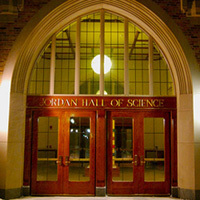

For a only the second time, the University of Notre Dame Haiti Program was honored to host its international partners for their bi-annual meeting on the elimination of Lymphatic Filariasis (LF), more commonly known as elephantiasis. The meeting, held on July 24 and 25 in the Jordan Hall of Science, offered a platform for some 20 participants, representing a host of organizations, to update progress made in past six months, discuss mutual challenges, and plan for common strategic efforts to achieve the goal of elimination of this dreaded and disfiguring disease in Haiti by the year 2020. The only other time the group has travelled to Notre Dame was in 2009.
The Haiti Program’s Rev. Thomas Streit, C.S.C., founder and principal investigator (PI) and Earl Carter, managing director, as well as Gregory P. Crawford, William K. Warren Foundation Dean of the College of Science, warmly welcomed the participants from different partner organizations, and assured the group of the University’s continuing commitment to this important cause. Participating in the two-day conference were representatives of the Haitian Ministry of Health (MSPP), USAID, Centers for Disease Control and Prevention (CDC), IMA World Health, RTI International, CBM, as well as the University of Notre Dame. Other supporters of the overall effort were able to participate in the meeting remotely from as far away as Florida and Texas.
The meeting was an opportunity for each partner organization to share updates on Mass Drug Administration (MDA) activities, which is the primary, legacy tool to eliminate LF. In particular, the group discussed the financial challenges that each organization is facing in completing the fourth and fifth (of five continuous) years of nationwide MDA prescribed by World Health Organization (WHO) protocol, as well as follow-on surveys of MDA effectiveness. Also at the forefront of discussions was the emerging salt co-fortification program championed by Notre Dame, and supported by MSPP, which promises not only improved intellectual capacity through the country’s first supply chain of clean, iodized salt, but also long-term assurance that LF will be eradicated once the salt is utilized routinely in every town and home.

Another key element addressed during the meeting was the morbidity management of LF patients. Morbidity management includes wound care and psychosocial counseling, both of which have been offered at Hospital St. Croix (HSC) in Leogane, Haiti, thanks to the benevolence of the Notre Dame family, and also limited-scope, corrective surgery. Also discussed was an emerging partnership with a non-profit organization that promises to afford enhanced wound care services to patients at HSC, the only specialized center for LF morbidity management in the whole of the Caribbean Island nation. The MSPP representatives to the meeting expressed interest in offering similar morbidity management services in other areas of the country, and communicated the support of the Haitian minister of health for the morbidity component of the program. Continued training of MSPP-designated individuals will allow local hospitals to provide similar care to people with LF clinical manifestations across Haiti.
Because of the importance of continuing research in LF elimination, under the direction of Rev. Streit, marketing surveys are ongoing in order to evaluate the level of salt penetration in the population. Also, LF transmission assessment surveys have been planned, since a lot of the nation’s communes have met the criteria to evaluate the impact of MDA activities in the population. It is expected that the outcome of these surveys will provide valuable information that will help in the decision-making about scaling down MDA as elimination efforts reach “the home stretch.”
Participants left the meeting unified and cautiously optimistic about success of their mutual efforts to support the people of Haiti in elimination of LF by 2020 — and hopeful for the continued partnership of government, corporate, and individual benefactors, without whose continuing generosity this imminently achievable humanitarian goal may not be realized.
Originally published by at haiti.nd.edu on September 05, 2014.